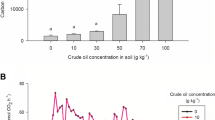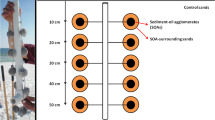Abstract
Abiotic and biotic processes associated with the degradation of a light petroleum in brines close to the salt-saturation (~31 %) and the effect of labile organic matter (LOM) supply (casaminoacids/citrate; 0.2 and 0.1 % w/v, respectively) were followed during an incubation of 30 days. After 4-week incubation at 40 °C under light/dark cycles, a 24 % of abiotic degradation was observed in untreated brines. The stimulation of native brines community with LOM addition allowed an additional 12.8 % oil attenuation due to biodegradation processes. Successional changes in the active microbial community structure due to the oil contamination (16S rRNA DGGE approach) showed the selection of one phylotype affiliated to Salinibacter and the disappearance of Haloquadratum walsbyi in untreated brines. In LOM-amended microcosms, phylotypes related to Salinibacter, Haloarcula, Haloterrigena and Halorhabdus were selected. An effect of hydrocarbon contamination was only observed in the bacterial community with the inhibition of two dominant proteobacterial phylotypes. This study further confirms that short-term and moderate oil biodegradation is possible in LOM-stimulated brines. Biodegradation should be much more reduced under in situ conditions. Self-cleaning capacities of close to saturation hypersaline lakes appears, therefore very limited compared to non-extreme haline environments.






Similar content being viewed by others
References
Al-Mailem DM, Sorkhoh NA, Al-Awadhi H et al (2010) Biodegradation of crude oil and pure hydrocarbons by extreme halophilic archaea from hypersaline coasts of the Arabian Gulf. Extremophiles 14:321–328
Al-Mailem DM, Eliyas M, Radwan SS (2012) Enhanced haloarchaeal oil removal in hypersaline environments via organic nitrogen fertilization and illumination. Extremophiles 16:751–758
Al-Mailem DM, Eliyas M, Radwan SS (2013a) Bioremediation of oily hypersaline soil and water via potassium and magnesium amendment. Can J Microbiol 59:837–844
Al-Mailem DM, Eliyas M, Radwan SS (2013b) Oil-bioremediation potential of two hydrocarbonoclastic, diazotrophic Marinobacter strains from hypersaline areas along the Arabian Gulf coasts. Extremophiles 17:463–470
Al-Mailem D, Eliyas M, Khanafer M, Radwan S (2014a) Culture-dependent and culture-independent analysis of hydrocarbonoclastic microorganisms indigenous to hypersaline environments in Kuwait. Microb Ecol 67:857–865
Al-Mailem DM, Eliyas M, Radwan S (2014b) Enhanced bioremediation of oil-polluted, hypersaline, coastal areas in Kuwait via vitamin-fertilization. Environ Sci Pollut Res 21:3386–3394
Alonso-Gutiérrez J, Figueras A, Albaigés J et al (2009) Bacterial communities from shoreline environments (Costa da Morte, Northwestern Spain) affected by the Prestige oil spill. Appl Environ Microbiol 75:3407–3418
Altschul SF, Gish W, Miller W et al (1990) Basic local alignment search tool. J Mol Biol 215:403–410
Antón J, Oren A, Benlloch S, et al. (2002) Salinibacter ruber gen. nov., sp. nov., a novel, extremely halophilic member of the Bacteria from saltern crystallizer ponds. Int J Syst Evol Microbiol 52:485–491
Atlas RM (1975) Effects of temperature and crude oil composition on petroleum biodegradation. Appl Microbiol 30:396–403
Bertrand JC, Almallah M, Acquaviva M, Mille G (1990) Biodegradation of hydrocarbons by an extremely halophilic archaebacterium. Lett Appl Microbiol 11:260–263
Bingeman CW, Varner JE, Martin WP (1953) The effect of the addition of organic materials on the decomposition of an organic soil. Soil Sci Soc Am J 17:34. doi:10.2136/sssaj1953.03615995001700010008x
Blanck H, Dahl B (1998) Recovery of marine periphyton communities around a Swedish marina after the ban of TBT use in antifouling paint. Mar Pollut Bull 36:437–442
Bonfa MR, Grossman MJ, Mellado E, Durrant LR (2011) Biodegradation of aromatic hydrocarbons by Haloarchaea and their use for the reduction of the chemical oxygen demand of hypersaline petroleum produced water. Chemosphere 84:1671–1676
Burns DG, Janssen PH, Itoh T, et al. (2007) Haloquadratum walsbyi gen. nov., sp. nov., the square haloarchaeon of Walsby, isolated from saltern crystallizers in Australia and Spain. Int J Syst Evol Microbiol 57:387–392
Casamayor EO, Calderón-Paz JI, Pedrós-Alió C (2000) 5S rRNA fingerprints of marine bacteria, halophilic archaea and natural prokaryotic assemblages along a salinity gradient. FEMS Microbiol Ecol 34:113–119
Delille D, Delille B, Pelletier E (2002) Effectiveness of bioremediation of crude oil contaminated subantarctic intertidal sediment: the microbial response. Microb Ecol 44:118–126
Djeridi I, Militon C, Grossi V, Cuny P (2013) Evidence for surfactant production by the haloarchaeon Haloferax sp. MSNC14 in hydrocarbon-containing media. Extremophiles 17:669–675
Edgar RC (2004) MUSCLE: multiple sequence alignment with high accuracy and high throughput. Nucleic Acids Res 32:1792–1797
Fathepure BZ (2014) Recent studies in microbial degradation of petroleum hydrocarbons in hypersaline environments. Front Microbiol. doi:10.3389/fmicb.2014.00173
Gertler C, Yakimov MM, Malpass MC, Golyshin PN (2010) Shipping-related accidental and deliberate release into the environment. In: Handbook of Hydrocarbon and Lipid Microbiology. Springer, pp 243–256
Ghai R, Pašić L, Fernández AB, et al. (2011) New Abundant Microbial Groups in Aquatic Hypersaline Environments. Sci Rep. doi:10.1038/srep00135
Gomariz M, Martínez-García M, Santos F, et al. (2015) From community approaches to single-cell genomics: the discovery of ubiquitous hyperhalophilic Bacteroidetes generalists. ISME J 9:16–31. doi:10.1038/ismej.2014.95
Grossi V, Cravo-Laureau C, Guyoneaud R, et al. (2008) Metabolism of n-alkanes and n-alkenes by anaerobic bacteria: A summary. Org Geochem 39:1197–1203. doi: 10.1016/j.orggeochem.2008.02.010
Hamme JDV, Singh A, Ward OP (2003) Recent advances in petroleum microbiology. Microbiol Mol Biol Rev 67:503–549. doi:10.1128/MMBR.67.4.503-549.2003
Hammer Ø, Harper DAT, Ryan PD (2001) PAST: Paleontological statistics software package for education and data analysis. Palaeontol Electron 4(1):9
Hart DJ, Vreeland RH (1988) Changes in the hydrophobic-hydrophilic cell surface character of Halomonas elongata in response to NaCl. J Bacteriol 170:132–135
Head IM, Jones DM, Röling WF (2006) Marine microorganisms make a meal of oil. Nat Rev Microbiol 4:173–182
Hylland K (2006) Polycyclic Aromatic Hydrocarbon (PAH) Ecotoxicology in Marine Ecosystems. J Toxicol Environ Health A 69:109–123. doi:10.1080/15287390500259327
Jurelevicius D, Alvarez VM, Marques JM, et al. (2013) Bacterial community response to petroleum hydrocarbon amendments in freshwater, marine, and hypersaline water-containing microcosms. Appl Environ Microbiol 79:5927–5935
Jurelevicius D, de Almeida Couto CR, Alvarez VM et al (2014) Response of the archaeal community to simulated petroleum hydrocarbon contamination in marine and hypersaline ecosystems. Water Air Soil Pollut 225:1–12
Kebbouche-Gana S, Gana ML, Khemili S et al (2009) Isolation and characterization of halophilic Archaea able to produce biosurfactants. J Ind Microbiol Biotechnol 36:727–738
Kimura M (1980) A simple method for estimating evolutionary rates of base substitutions through comparative studies of nucleotide sequences. J Mol Evol 16:111–120
Lane DJ, Pace B, Olsen GJ, et al. (1985) Rapid determination of 16S ribosomal RNA sequences for phylogenetic analyses. Proc Natl Acad Sci 82:6955–6959
Leahy J, Colwell R (1990) Microbial degradation of hydrocarbons in the environment. Microbiol Rev 54:305–315
Lefebvre O, Moletta R (2006) Treatment of organic pollution in industrial saline wastewater: a literature review. Water Res 40:3671–3682
MacNaughton SJ, Stephen JR, Venosa AD et al (1999) Microbial population changes during bioremediation of an experimental oil spill. Appl Environ Microbiol 65:3566–3574
Margesin R, Schinner F (2001) Biodegradation and bioremediation of hydrocarbons in extreme environments. Appl Microbiol Biotechnol 56:650–663
McGenity TJ (2010) Halophilic hydrocarbon degraders. In: Timmis KN (ed) Handbook of hydrocarbon and lipid microbiology. Springer-Verlag Berlin Heidelberg, Berlin, pp 1939–1951
Militon C, Jézéquel R, Gilbert F, et al. (2015) Dynamics of bacterial assemblages and removal of polycyclic aromatic hydrocarbons in oil-contaminated coastal marine sediments subjected to contrasted oxygen regimes. Environ Sci Pollut Res 22:15260–15272
Mutlu MB, Martínez-García M, Santos F, et al. (2008) Prokaryotic diversity in Tuz Lake, a hypersaline environment in Inland Turkey. FEMS Microbiol Ecol 65:474–483, doi:10.1111/j.1574-6941.2008.00510.x
Nomura M, Gourse R, Baughman G (1984) Regulation of the Synthesis of Ribosomes and Ribosomal Components. Annu Rev Biochem 53:75–117. doi:10.1146/annurev.bi.53.070184.000451
Oren A (1999) Bioenergetic aspects of halophilism. Microbiol Mol Biol Rev 63:334–348
Oren A (2001) The bioenergetic basis for the decrease in metabolic diversity at increasing salt concentrations: implications for the functioning of salt lake ecosystems. Hydrobiologia 466:61–72
Oren A, Arahal DR, Ventosa A (2009) Emended descriptions of genera of the family Halobacteriaceae. Int J Syst Evol Microbiol 59:637–642
Pérez-Pantoja D, González B, Pieper DH (2010) Aerobic degradation of aromatic hydrocarbons. In: Timmis KN (ed) Handbook of hydrocarbon and lipid microbiology. Springer-Verlag, Berlin Heidelberg, Berlin, pp 799–837
Plotnikova EG, Altyntseva OV, Kosheleva IA et al (2001) Bacterial degraders of polycyclic aromatic hydrocarbons isolated from salt-contaminated soils and bottom sediments in salt mining areas. Microbiology 70:51–58. doi:10.1023/A:1004892804670
Redmond MC, Valentine DL (2012) Natural gas and temperature structured a microbial community response to the Deepwater Horizon oil spill. Proc Natl Acad Sci 109:20292–20297. doi: 10.1073/pnas.1108756108
Rhykerd RL, Weaver RW, McInnes KJ (1995) Influence of salinity on bioremediation of oil in soil. Environ Pollut 90:127–130
Rojo F (2010) Enzymes for aerobic degradation of alkanes. In: Timmis KN (ed) Handbook of hydrocarbon and lipid microbiology. Springer-Verlag, Berlin Heidelberg, Berlin, pp 781–798
Röling WF, Milner MG, Jones DM et al (2004) Bacterial community dynamics and hydrocarbon degradation during a field-scale evaluation of bioremediation on a mudflat beach contaminated with buried oil. Appl Environ Microbiol 70:2603–2613
Saitou N, Nei M (1987) The neighbor-joining method: a new method for reconstructing phylogenetic trees. Mol Biol Evol 4:406–425
Schneegurt MA (2012) Media and conditions for the growth of halophilic and halotolerant bacteria and archaea. In: Advances in Understanding the Biology of Halophilic Microorganisms. Springer, pp 35–58
Shimizu S (2001) Vitamins and related compounds: microbial production. In: Rehm H-J, Reed G (eds) Biotechnology. Wiley, New York, pp 318–340
Southworth GR (1979) The role of volatilization in removing polycyclic aromatic hydrocarbons from aquatic environments. Bull Environ Contam Toxicol 21:507–514. doi:10.1007/BF01685462
Tamura K, Stecher G, Peterson D et al (2013) MEGA6: molecular evolutionary genetics analysis version 6.0. Mol Biol Evol 30:2725–2729
Tapilatu YH, Grossi V, Acquaviva M et al (2010) Isolation of hydrocarbon-degrading extremely halophilic archaea from an uncontaminated hypersaline pond (Camargue, France). Extremophiles 14:225–231
Usami R, Fukushima T, Mizuki T, et al. (2005) Organic solvent tolerance of halophilic archaea, Haloarcula strains: Effects of NaCl concentration on the tolerance and polar lipid composition. J Biosci Bioeng 99:169–174. doi:10.1263/jbb.99.169
Ventosa A, Nieto JJ, Oren A (1998) Biology of moderately halophilic aerobic bacteria. Microbiol Mol Biol Rev 62:504–544
Ward DM, Brock TD (1978) Hydrocarbon biodegradation in hypersaline environments. Appl Environ Microbiol 35:353–359
Wessel N, Santos R, Menard D et al (2010) Relationship between PAH biotransformation as measured by biliary metabolites and EROD activity, and genotoxicity in juveniles of sole (Solea solea). Mar Environ Res 69(Suppl):S71–S73. doi:10.1016/j.marenvres.2010.03.004
Wright ES, Yilmaz LS, Noguera DR (2012) DECIPHER, a Search-Based Approach to Chimera Identification for 16S rRNA Sequences. Appl Environ Microbiol 78:717–725. doi: 10.1128/AEM.06516-11
Yakimov MM, Denaro R, Genovese M, et al. (2005) Natural microbial diversity in superficial sediments of Milazzo Harbor (Sicily) and community successions during microcosm enrichment with various hydrocarbons. Environ Microbiol 7:1426–1441
Zheng S, Qiu X, Chen B et al (2011) Toxicity evaluation of benzo [a] pyrene on the polychaete Perinereis nuntia using subtractive cDNA libraries. Aquat Toxicol 105:279–291
Acknowledgments
The work was carried out as part of Yannick Corsellis’s PhD research, of Marc Krasovec’s master these and of the French National Program EC2CO BEMOL (Biodégradation des hydrocarbures dans les Écosystèmes hypersalés: Mythe Ou réaLité ?). We thank the Centre National de la Recherche Scientifique (CNRS) and the Institut National des Sciences de l’Univers (INSU) for financial support. Yannick Corsellis was granted a MERNT fellowship (Ministry of Education, Research and Technology, France). We thank the Salins Company for given us access to their hypersaline lake, Anne-Marie Abrard and Georges Argyris for the valuable help for the sampling period. We dedicate this paper to the memory of Michel Matra.
Author information
Authors and Affiliations
Corresponding author
Additional information
Communicated by F. Robb.
Electronic supplementary material
Below is the link to the electronic supplementary material.
Rights and permissions
About this article
Cite this article
Corsellis, Y.Y., Krasovec, M.M., Sylvi, L.L. et al. Oil removal and effects of spilled oil on active microbial communities in close to salt-saturation brines. Extremophiles 20, 235–250 (2016). https://doi.org/10.1007/s00792-016-0818-x
Received:
Accepted:
Published:
Issue Date:
DOI: https://doi.org/10.1007/s00792-016-0818-x




